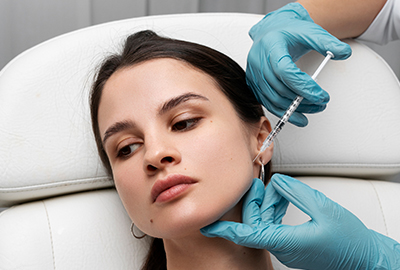
There is a lot of recent discussion about Botulinum injections being offered as the latest treatment for temporomandibular disorder and associated pain. While there are some very real benefits of including this in management, it is important to understand more about how, when and why Botulinum fits into a broader management approach and that it should never be a stand-alone treatment.
Muscle pain forms a large part of the clinical presentation for many of the conditions we treat including Temporomandibular Disorder (TMD), headaches, earache and other facial pains.
Muscle pain can result for a number of complex reasons but for the ease of understanding, the following explanation is a significant aspect of the origins of muscle pain.
When muscles contract excessively due to overuse, or spasm as a response to pain, they can develop areas of hyper contraction that feel like ‘knots’. We call these ‘trigger points’. These areas of the muscle feel thicker (hence the misconception that they are knotted). The trigger points develop pain at the site of hypercontraction which we term ‘the local pain’ but can also create a ‘referred pain’ felt elsewhere. This referred pain is often confusing leading to the sense that the pain is coming from the structure where that referred pain is felt. This could thus mimic ear pain, tooth pain, sinus pain etc.
When muscles are in a state of excess contraction / tension, they cannot function optimally. Additionally they exert pressure on the joints that they act on / are associated with.
An example are the masticatory (chewing) muscles like the masseter and temporalis muscles.
When these muscles are overworked, they can become very tight and tender producing pain in many areas of the head and face. The excess activity can also create undue pressure on the temporomandibular joints which these muscles are associated with.
This is achieved in a number of ways
Although more indirect, we always mobilize the associated joints in the areas being treated in order to have a more complete therapeutic effect for the areas that have become dysfunctional and painful. This means we work on the joints themselves to improve their movement.
Sometimes, despite incorporating all the above mentioned techniques (including patient self management and behavioral modifications) in our treatment process, the muscles we are treating continue to remain over-active, very tense and pain producing. This is where a real benefit lies in incorporating muscle relaxant injection therapy (MRIT) into our treatment process.
Occasionally there is also benefit in incorporating MRIT early in patient management. This would be when severe pain is not responding sufficiently to pain-killer medications, is affecting the patient’s ability to function and limits the benefit of manual therapy. MRIT in these cases would act as a ‘pain-breakthrough’ thus facilitating better responses to the rest of our treatment process.’

Although the inclusion of MRIT is not new, it has become much more mainstream and evidenced based in recent years. The injection of muscle relaxants like products Botulinum has become much more widely used for the treatment of muscle tension and pain. Botulinum injections are commonly used by Neurologists for the treatment of Migraine headache as well as other muscular disorders. They have also become widely used in the treatment of clenching and grinding due to its effect in weakening the muscles ability to contract forcefully.
Injection of muscle relaxants like Botulinum interferes with the connection between the nerve and the muscle (the neuro-muscular junction) and stops the muscle from being able to contract. As a result of this, the tension in the hyper contracted bands of muscle relaxes and this usually results in a reduction in the pain the muscle is producing. Besides relaxing the muscle, Botulinum can have an indirect analgesic effect by interfering with the pain pathway (blocking pain signals) and reducing pain sensitisation in the injured or painful structures.
The effects do wear off over a number of months as the neuro-muscular junction recovers and contraction returns. For this reason, if necessary, repeat treatment every 3-4 months may be required. It is hoped though, that MRIT when included as part of the overall treatment process, acts as a one-time ‘circuit breaker’ in more resistant cases – allowing for the therapy to then have greater effect.
MRIT is only an adjunct to therapy as it does not address the root cause of dysfunction and resultant tension / pain.
MRIT using Botulinum should only be incorporated in cases when other mentioned techniques have already been included and reached a plateau in improvements or in acute cases as described above.
It is always best to receive MRIT from an experienced Medical / Dental professional that understands the rest of the treatment process you are undergoing, and who is conservative in the amount (units) of muscle relaxant being injected.
Our team GP with special interest in Musculoskeletal & Dermatological medicine Dr Braham Goldberg is available to assist you with MRIT.
Next Steps
For Rapid Relief & Lasting Results Call (03) 9824 8868
(03) 9824 8868
OrClick Here to Book Online